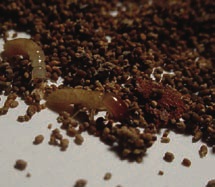PESTS AND DISEASES OF FORESTRY IN NEW ZEALAND
Subterranean termites found in Nelson
From Biosecurity 67, May 2006.
A colony of Australian subterranean termites, Coptotermes acinaciformis, was recently reported from a property in Richmond, Nelson. The species is the same one that was declared eradicated in 2005 from sites at Otorohanga, Morrinsville and Matamata.
Biosecurity New Zealand’s (BNZ’s) initial investigations indicate that the termites appear to have arrived in Richmond concealed within imported Australian used railway sleepers more than 10 years ago. Current MAF border control regulations require all imported railway sleepers to be stopped and fumigated on arrival at the border.
The railway sleepers at the property have been used for landscaping, and over a 10-year period the termites have entered the house via the plumbing. Internal damage has been observed to some of the untreated internal and external timber wall framing.

hitchhiked to New Zealand in some used railway sleepers.
Termites are cryptic insects and BNZ is working very closely with local homeowners and councils to ensure that any suspect insect activity is investigated.
Results of a delimiting survey carried out in late March indicate that the infestation is confined to two neighbouring properties. No activity has been found outside the immediate area where the termites were originally reported.
The current response is being guided by the experience gained in eradicating a large population of termites from Otorohanga. To date, wooden monitoring stakes and sticky traps have been placed at the site, and a delimiting survey has been completed.
To eradicate the termites, BNZ will be installing the Sentricon baiting system. This system was the main response tool used at Otorohanga and is very effective at eradicating termites. It relies on the use of bait stations containing the active ingredient hexa?umuron, which prevents termites from moulting. This results in death and the eventual elimination of the colony.
This incursion is the first time that this species of termite has been found in the South Island, and currently there are no other known active subterranean termite sites in New Zealand.
Native termites not a threat
New Zealand has three species of indigenous termites: Kalotermes brouni Frogatt (Isoptera: Kalotermitidae), Stolotermes ruficeps Brauer (Isoptera: Termopsidae) and Stolotermes inopinus Gay (Isoptera: Termopsidae) (Milligan 1984). These are not considered to be destructive. Indigenous termites do not form large colonies and usually affect only a small portion of any wooden structure.
Mark Ross, Senior Adviser, Surveillance and Incursion Response, Biosecurity New Zealand, phone 04 819 0535, mark.ross@maf.govt.nz
Subterranean Termites, Nelson
Don Hammond (From NZIF newsletter Number 2007/26 – 6 July 2007)
A colony of Australian subterranean termites, Coptotermes acinaciformis , was reported from a single property in Richmond, Nelson in January 2006. Biosecurity New Zealand initial investigations indicated that the termites appear to have arrived in Richmond concealed within imported Australian used railway sleepers more than 10 years ago.
A delimiting survey resulted in termite activity being located at two neighbouring properties. A strategy has been implemented involving placement of wooden monitoring stakes and implementation of the Sentricon baiting system. Another delimiting survey of 38 properties within a 100 metre radius of the infected 2 properties was completed late November 2006 but there was no additional activity located.
Inspections throughout summer 2006/07 indicated that termites were ingesting considerable amounts of toxic baits. The latest bait station inspections were completed at the end of March 2007 and at the beginning of May 2007 and in June 2007. There were no signs of termites’ activity, thus indicating that the colony is eliminated. A monitoring programme will be operated for up to 5 years before the infestation can be declared eradicated. Biosecurity New Zealand is optimistic about successful eradication of C. acinaciformis from Richmond, Nelson.

 Farm Forestry New Zealand
Farm Forestry New Zealand

